Audi quattro
Audi astounded the world with the 4WD quattro, introduced 25 years ago this March. Andrew Noakes looks back.
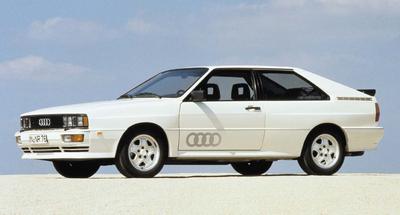
Quattrophenia!
Four-wheel drive was for farmers and foresters, until the quattro came along. There had been the odd flourish of fast 4x4 over the years, notably in the late 1960s when the Jensen FF and a handful of unsuccessful F1 and Indy cars appeared.
The quattro launches
But the idea didn’t catch on until 1980, when dull but dependable Audi presented its new performance car for the first time at the Geneva show. It marked the beginning of an era of turbocharged, four-wheel drive road cars and changed the face of rallying overnight.
The first seeds were sown in the mid-1970s, when Volkswagen designed an off-road 4x4 called the Iltis, largely by plundering the existing Volkswagen/Audi parts bin. Iltis experience led Audi engineers (notably Ferdinand Piëch, now Volkswagen chairman) to investigate the benefits of four-wheel drive in a high-performance road car, starting with an old-shape Audi 80.
Once Audi management had been convinced of the four-wheel drive car’s superiority in adverse conditions by back-to-back tests with standard front-drive cars, Piëch was given the green light to develop a high-performance, four-wheel drive machine for road and rallying.
Engaging transmission
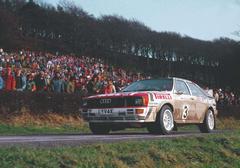 Established Audi practice was to hang an in-line engine longitudinally in the nose, with the gearbox behind the axle line and the final drive to the front wheels between them. The clever part of the new four-wheel drive transmission was that the gearbox output shaft was hollow, and drove a centre differential (actually a modified Audi 50/VW Polo diff) at its rear end. Drive was taken from the centre diff through the hollow gearbox output shaft to the front wheels and by a split propshaft to the rear wheels. The result was an amazingly light and
Established Audi practice was to hang an in-line engine longitudinally in the nose, with the gearbox behind the axle line and the final drive to the front wheels between them. The clever part of the new four-wheel drive transmission was that the gearbox output shaft was hollow, and drove a centre differential (actually a modified Audi 50/VW Polo diff) at its rear end. Drive was taken from the centre diff through the hollow gearbox output shaft to the front wheels and by a split propshaft to the rear wheels. The result was an amazingly light and 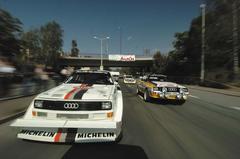 compact system which permanently drove all four wheels.
compact system which permanently drove all four wheels.
Both centre and rear diffs could be locked by dog clutches to provide optimum traction in severe conditions – even with four-wheel drive a single wheel with no grip would still halt progress. With both diffs in their normal ‘open’ state the benefit of the 4x4 system was that each tyre was called upon to transmit less tractive effort, so the chances of a wheel spinning were much reduced.
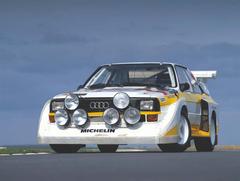 During testing, Audi also found another benefit: tyres generate less rolling resistance when driven gently than when rolling freely, more than enough to offset the additional frictional losses in the four-wheel-drive transmission. Prototypes delivered higher maximum speeds when driven by all four wheels than when the rear driveshafts were removed.
During testing, Audi also found another benefit: tyres generate less rolling resistance when driven gently than when rolling freely, more than enough to offset the additional frictional losses in the four-wheel-drive transmission. Prototypes delivered higher maximum speeds when driven by all four wheels than when the rear driveshafts were removed.
Performance
Power came from a turbocharged version of Piëch’s favourite five-cylinder engine, 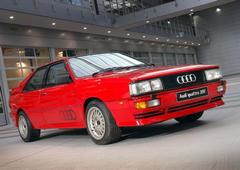 already under development for the 200 5T saloon and producing 170bhp. For the quattro it gained an intercooler and an electronic ignition system with an intake air temperature sensor, together with higher boost (up from 0.75bar to 0.85bar, about 12psi) and a bigger exhaust system, but the alloy head still had only two valves per cylinder. Output was boosted to 200bhp at 5500rpm.
already under development for the 200 5T saloon and producing 170bhp. For the quattro it gained an intercooler and an electronic ignition system with an intake air temperature sensor, together with higher boost (up from 0.75bar to 0.85bar, about 12psi) and a bigger exhaust system, but the alloy head still had only two valves per cylinder. Output was boosted to 200bhp at 5500rpm.
At its Geneva launch, the quattro (Audi always preferred a lower-case Q) was the talk of the show, its pugnacious styling and technical 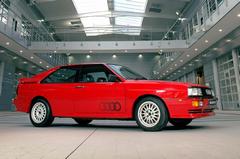 sophistication wowing the crowds. Road tests by the press soon confirmed its awesome ability in tricky conditions, but few thought it was perfect and much criticism was levelled at the lethargic engine response at low speeds. Motor magazine revealed that at full throttle in fifth gear a quattro was slower from 20 to 60mph than a 900cc VW Polo, but from 60 to 100mph it was quicker than a Porsche 911SC.
sophistication wowing the crowds. Road tests by the press soon confirmed its awesome ability in tricky conditions, but few thought it was perfect and much criticism was levelled at the lethargic engine response at low speeds. Motor magazine revealed that at full throttle in fifth gear a quattro was slower from 20 to 60mph than a 900cc VW Polo, but from 60 to 100mph it was quicker than a Porsche 911SC.
The first cars were left-hand-drive only, but right-hookers appeared late in 1982. 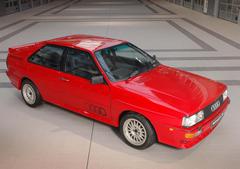 A revised version arrived in 1984, the wider wheels and stiffer suspension being almost ignored in the rush of complaints about the new talking digital dashboard. This, remember, was the era of the Austin Maestro.
A revised version arrived in 1984, the wider wheels and stiffer suspension being almost ignored in the rush of complaints about the new talking digital dashboard. This, remember, was the era of the Austin Maestro.
Rallying improves the breed
But it was also the era of four-wheel drive rally cars, largely thanks to Audi’s efforts (along with Renault and Lancia) to lift the ban on all-drive entries. The works Audis made an inauspicious debut at the Monte Carlo Rally in 1981, Michele Mouton retiring with fuel system woes and Hannu Mikkola crashing out of the lead. But the quattros were soon winning, and they headed the 1982 Manufacturers’ championship. Audi Sport UK’s rally quattro, registered LYV4X (top pic) won the British championship in the hands of Mikkola and co-driver Arne Hertz.
By then, Lancia was beginning to exploit the new Group B rules to get ahead of the Audis, but Ingolstadt hit back with its own Group B machine, the Sport quattro. Sacrificing some of the original quattro’s generous interior space with a 320mm wheelbase chop and swapping steel panels for composite, Audi saved weight and made the Sport quattro a more wieldy rally machine. An alloy engine block contributed to the weight saving, and on top sat a new 20-valve head which helped boost the road version’s power output to 304bhp. Works rally machines were rumoured to be developing 450bhp.
The modern quattro
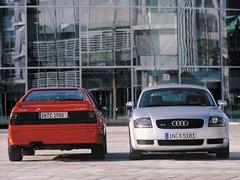 The road quattro would eventually get its own 20-valve head, but not just yet. The next revision was the introduction of a 2,226cc engine in 1988, controlled by a Bosch engine management system incorporating a knock sensor which allowed the compression ratio to be raised. Peak power and torque figures were unchanged, but that off-boost tardiness was now reduced. A Torsen centre diff was also fitted, to replace the old manual diff-lock.
The road quattro would eventually get its own 20-valve head, but not just yet. The next revision was the introduction of a 2,226cc engine in 1988, controlled by a Bosch engine management system incorporating a knock sensor which allowed the compression ratio to be raised. Peak power and torque figures were unchanged, but that off-boost tardiness was now reduced. A Torsen centre diff was also fitted, to replace the old manual diff-lock.
The 20-valve head appeared in 1990, raising the quattro’s power output to 220bhp and providing 228lb-ft from just 1,950rpm. 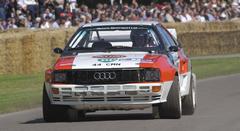 Though the launch of an aerodynamically-smoothed S2 quattro with a similar engine and transmission made the original car (known in Germany as the 'ur-quattro') look all of its 10 years old, there were many who still thought the old stager was the better machine. Those who still do delight in the regular appearances of Historic Motorsport Ltd’s rally quattros at events like the Goodwood Festival of Speed (right).
Though the launch of an aerodynamically-smoothed S2 quattro with a similar engine and transmission made the original car (known in Germany as the 'ur-quattro') look all of its 10 years old, there were many who still thought the old stager was the better machine. Those who still do delight in the regular appearances of Historic Motorsport Ltd’s rally quattros at events like the Goodwood Festival of Speed (right).
Drive one today and the ur-quattro still makes a convincing case for itself. And few would argue that the quattro – the car that re-wrote the rulebook in more ways than one – is an all-time classic.
Links
Gassing Station | Audi, Seat, Skoda & VW | Top of Page | What's New | My Stuff







